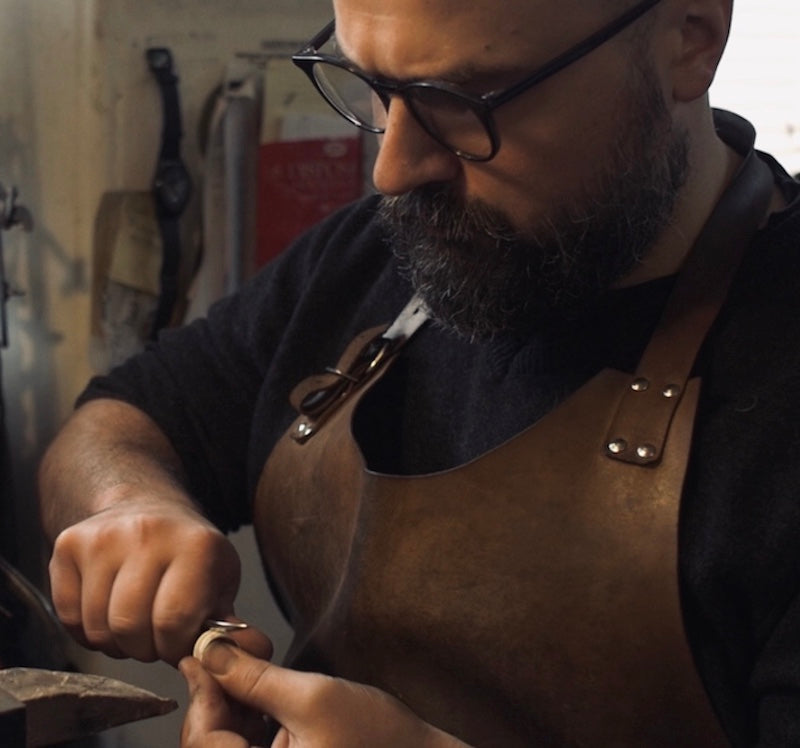
Gleaming Delights: Taking care of Scottish Silver
From the remnants of silver Roman coins buried deep in the soil of the Borders, to Clackmannanshire’s Silver Glen, Scotland’s connections with silver are threaded throughout our history.
Only a select few continue the traditional means of production. With Lost Artisans, Colin and Maciek follow in the footsteps of the Hammermen of Glasgow continuing traditional means of creation, alteration and repair with original tools and resources.
Maciek using traditional methods to hand-chase solid 925 silver using traditional, hundreds year old tools.
If your piece is vintage, or you do not know your maker, you can investigate their history by identifying your handmade piece’s hallmarks. These can classify the quality of silver, location of production, and sometimes even the maker themselves.

Maciek's Small Silver Keepsake Box, lid adorned with hand chased waves and body stamped with hallmarks as signification of 925 quality, place of production and maker. Learn more about this handcrafted piece here .
Regardless of the quality of your silver, have you ever noticed your silvers shifting in tone? Without due care and attention silver will inevitably tarnish over time, forming a dull film, preventing your piece from shining. Although unwelcome, this is a natural process - a result of contact with everyday chemicals (primarily sulphur and oxygen) and humidity.
The good news is, although tricky to remove, tarnish does not penetrate the silver and only affects the surface layer. This is preventable and can be removed with dedicated time and appropriate compositions of everyday household materials.
For the precious silvers in your life, our silver experts recommend the following handy advice to maintain gleaming mirrored shine:
Daily care
Take a minute or so every day to buff your silver with a fresh, soft, lint-free cloth. Daily care maintains its shine and can prevent dulling.
Store in soft bags
When your silverware or jewellery is not in use, store it in store separately in soft, lint-free bags and in an airtight box. This reduces oxidisation and contact with everyday chemicals, delaying the tarnishing process.
Display appropriately
For your silver homewares be sure to display in an appropriate aesthetically pleasing place. This involves:
- displaying in a temperate space where there are no extreme shifts in temperature occur (ie, not beside an open window, radiator),
- avoiding contact with everyday chemicals (display away from scented candles, humidifiers). This includes removing or covering silver jewellery if you work in heavy industry,
- avoid contact with direct sunlight. This is a given – we’ve all seen the movies.
Adorn jewellery once you’re ready to leave
The scents and soaps we love do not help our silver and can contribute towards the build up of grime and accelerate tarnishing. So, adorn your jewellery last thing once moisturisers have soaked in, and the alcohol from perfume has evaporated, just when you’re ready to embark on your day.
Wear your silver jewellery often
Daily wearing jewellery often takes longest to tarnish, since gentle friction from clothes can buff off any build-up.
Remove jewellery at night
Removing silver jewellery at night can help to reduce contact with natural body oils – a contributing factor in tarnish build-up. Plus, in the case of necklaces, chains and bracelets, storing your wares while in your slumber can avoid the heartbreak of potential breakage.
Clean weekly if shine begins to fade
If your silver is particularly fussy, it can be cleaned weekly with a soft cloth or baby toothbrush, gentle soap and tepid water. By buffing away a weeks’ residue, you can prevent the inevitable tarnish build up.
Removing tarnish - the deep clean
If your silver has significantly shifted in colour, there’s no need to panic. You can use the previous method to remove tarnish however this could take significant time.
A quicker method involves soaking silver in ½ cup of white vinegar diluted with ½ cup of water, then buffing with a clean cotton cloth or baby toothbrush. This method is particularly effective in refreshing any grooves or hand chases in design.
Alternatively - for a more effervescent method - line a bowl or sink with aluminium foil, add a cup of freshly boiled water, ½ tablespoon of salt, ¼ tablespoon of baking soda. Watch the gentle chemical reaction lifts your silver back to life.
After either method, allow pieces to air dry for up to a minute then buff with a fresh, cotton cloth. Admire the sparkle and shine as your silver comes back to life.
If the tarnish on your piece is particularly stubborn, or damaged in any way, all good silversmiths and jewellers will be happy to take a look at your commissioned piece. Your maker intended for your piece to be treasured for several lifetimes, and they know the best tricks of the trade.
What do you do to maintain your silver? Do you know any effective or defective auld wife’s tales? Comment your thoughts below – we love to hear what you think.


Leave a comment
Your email address will not be published. Required fields are marked *